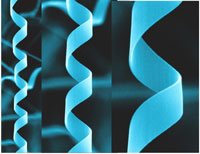Materials management deals with the research, development, manufacturing and processing of raw and industrial materials. Key aspects here are biological and medical issues, which play an increasingly important role in this field.
innovations-report offers in-depth articles related to the development and application of materials and the structure and properties of new materials.

Researchers at the U.S. Department of Energy’s Brookhaven National Laboratory have discovered a way to significantly increase the amount of electric current carried by a high-temperature superconductor, a material that conducts electricity with no resistance. This is an important step in the drive to create superconductor-based electric and power-delivery devices, such as power transmission lines, motors, and generators. The results are explained in the September 12, 2005, online edition of

Microbian evolution on a wide variety of surfaces can produce phenomena such as corrosion, dirt, smells and even serious hygiene and health problems.
It is well known there is a great interest in the design and development of the so-called “hygienic surfaces”, referring to surfaces that not only provides biocidal activity but also to those that are easy to clean and even self-cleaning.
Achieving these properties on a surface is possible by means of coatings and treatments

Nanorods of many materials are proving very successful, and their properties often exceed that of nanotubes, making them excellent candidates for industrial applications. Theoretical calculations predicted that diamond nanorods too would have properties superior to that of carbon nanotubes. But, so far, nobody had been able to actually synthesize diamond nanorods. This is no longer true. A team from the Bayerisches Geoinstitut (Universität Bayreuth) has just reported the synthesis of these aggregat

The newest promising material for advanced technology applications is diamond nanotubes, and research at the U.S. Department of Energy’s Argonne National Laboratory is giving new insight into the nature of nanodiamond.
Argonne researcher Amanda Barnard, theorist in the Center for Nanoscale Materials, is working with colleagues at two Italian universities who produced innovative diamond-coated nanotubes.
The diamond-coated tubes resemble a stick of rock candy, hol

Based on superlattice nanobelts
A previously-unknown zinc oxide nanostructure that resembles the helical configuration of DNA could provide engineers with a new building block for creating nanometer-scale sensors, transducers, resonators and other devices that rely on electromechanical coupling.
Based on a superlattice composed of alternating single-crystal “stripes” just a few nanometers wide, the “nanohelix” structure is part of a family of nanobelts – tiny ribbon-l

A novel material that may demonstrate a highly unusual “liquid” magnetic state at extremely low temperatures has been discovered by a team of Japanese and U.S. researchers, according to tomorrow’s issue of Science.*
The material, nickel gallium sulfide (NiGa2S4), was synthesized by scientists at Kyoto University. Its properties were studied by both the Japanese team and by researchers from The Johns Hopkins University (JHU) and the University of Maryland (UM) at the Commerce